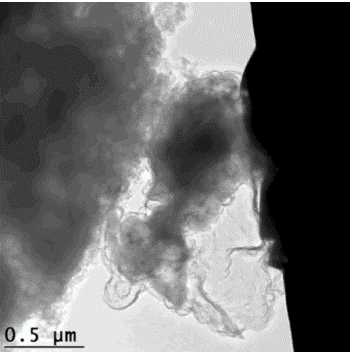Feb 1 2016
For years, scientists have been trying to use silicon to produce a lithium-ion battery anode capable of storing 10 times more energy than the existing commercial anodes, and making smaller and lighter batteries with superior performance. Previously there had been two major issues; silicon particles swell in size, and crack and break during the charging stage; and when they react with the electrolyte, they form a coating that decreases their performance.
 This time-lapse movie from an electron microscope shows the new battery material in action: a silicon particle expanding and cracking inside a graphene cage while being charged. The cage holds the pieces of the particle together and preserves its electrical conductivity and performance. (Hyun-Wook Lee/Stanford University)
This time-lapse movie from an electron microscope shows the new battery material in action: a silicon particle expanding and cracking inside a graphene cage while being charged. The cage holds the pieces of the particle together and preserves its electrical conductivity and performance. (Hyun-Wook Lee/Stanford University)
A research team from Stanford University and the Department of Energy’s SLAC National Accelerator Laboratory have presented a possible solution; wrapping each silicon anode particle in to a custom-fit graphene cage. Graphene is a pure form of carbon that is the strongest and thinnest material known, and an excellent conductor of electricity.
In an article published in the January 25th issue of Nature Energy, the team describe an easy, three-step procedure to build microscopic graphene cages of the right size; spacious enough to allow the silicon particle to expand as the battery is charged, but compact enough to hold the pieces together when the particle breaks, so that it can continue to function at high capacities. The sturdy, flexible cages also block unhealthy chemical reactions of the silicon particle with the electrolyte.
In testing, the graphene cages actually enhanced the electrical conductivity of the particles and provided high charge capacity, chemical stability and efficiency. The method can be applied to other electrode materials, too, making energy-dense, low-cost battery materials a realistic possibility.
Yi Cui, Associate Professor, SLAC and Stanford
Lithium-ion batteries work when lithium ions move back and forth in an electrolyte solution between the cathode and anode. Charging the battery forces the ions into the anode; using the battery moves the ions into the cathode.
Scientists trying to make silicon anodes have not been successful as silicon swells three times its size during charging. For Cui and his team, the search first led to anodes made up of silicon nanoparticles or nanowires, which so small that they are unlikely to break apart. The team came up with several ways to protect silicon nanoparticles; from pomegranate-resembling structures, to self-healing polymer coatings or conductive polymer hydrogels, similar to the ones used in soft contact lenses. But these were only partially successful; the efficiency of the anodes was not very high, the nanoparticles were hard to manufacture, and were expensive.
This new method allows us to use much larger silicon particles that are one to three microns, or millionths of a meter, in diameter, which are cheap and widely available. In fact, the particles we used are very similar to the waste created by milling silicon ingots to make semiconductor chips; they’re like bits of sawdust of all shapes and sizes. Particles this big, have never performed well in battery anodes before, so this is a very exciting new achievement, and we think it offers a practical solution.
Yi Cui, Associate Professor, SLAC and Stanford
For the best results, the graphene cages have to fit the silicon particles in a precise manner. The researchers achieved this in three steps: First, the silicon particles were coated with nickel, in the appropriate thickness. Layers of graphene were grown on top of the nickel, as nickel acts as a catalyst to facilitate graphene growth. Finally, nickel was etched away, leaving enough room inside the graphene cage for expansion of the silicon particle.
Researchers have tried a number of other coatings for silicon anodes, but they all reduced the anode’s efficiency. The form-fitting graphene cages are the first coating that maintains high efficiency, and the reactions can be carried out at relatively low temperatures.
Kai Yan, Postdoctoral Researcher, Stanford
The team proposes to work on fine-tuning the process, Li added, and mass-producing caged silicon particles so as to build commercial-scale batteries for testing.
Other researchers who contributed to the study were Stanford’s Hyun-Wook Lee, Zhenda Lu and Nian Liu. The research was undertaken by the Stanford Institute for Materials and Energy Sciences (SIMES) at SLAC, and was provided funds by the Battery Materials Research program of the DOE’s Vehicle Technologies Office.